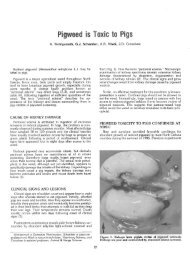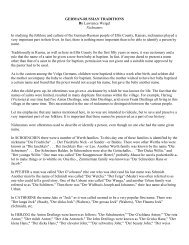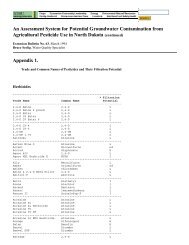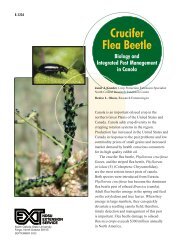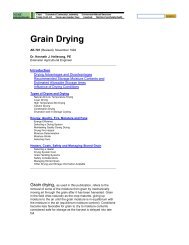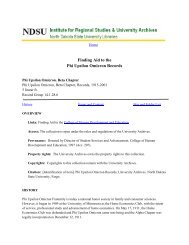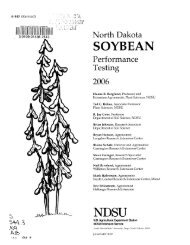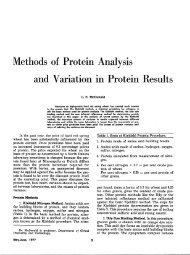germans from russia in fort collins, 1900-2000 - Libraries
germans from russia in fort collins, 1900-2000 - Libraries
germans from russia in fort collins, 1900-2000 - Libraries
Create successful ePaper yourself
Turn your PDF publications into a flip-book with our unique Google optimized e-Paper software.
WORK RENDERS LIFE SWEET: GERMANS FROM RUSSIA IN FORT COLLINS<br />
sugar factory <strong>in</strong> Loveland or helped to construct<br />
the new factory at Fort Coll<strong>in</strong>s, and the<br />
sugar company was more than will<strong>in</strong>g to<br />
assist hous<strong>in</strong>g them. In November 1902, the<br />
Fort Coll<strong>in</strong>s Colorado Sugar Company constructed<br />
small dwell<strong>in</strong>gs on land belong<strong>in</strong>g to<br />
Charles Buck<strong>in</strong>gham, next to the burgeon<strong>in</strong>g<br />
sugar plant. East of this settlement, Peter<br />
Anderson developed a section of his farm<br />
<strong>in</strong>to another neighborhood of German-<br />
Russian sugar beet workers.<br />
German-Russian Neighborhoods<br />
In his 1976 study of Larimer County’s<br />
Petitions for Naturalization <strong>from</strong> 1907 to<br />
1957, Dennis Means found that more than<br />
eighty-six percent of the German-Russian<br />
petitioners settled adjacent to the sugar factories<br />
<strong>in</strong> Loveland and Fort Coll<strong>in</strong>s. With over<br />
three-quarters of those settlers orig<strong>in</strong>at<strong>in</strong>g<br />
<strong>from</strong> the Volga River Region, it is little wonder<br />
why residents of Fort Coll<strong>in</strong>s referred to<br />
the two t<strong>in</strong>y neighborhoods at the foot of the<br />
sugar factor as “Little Saratov.”<br />
Geographically and socially isolated <strong>from</strong><br />
rest of the Fort Coll<strong>in</strong>s, Buck<strong>in</strong>gham Place<br />
and Andersonville concealed a rich and<br />
vibrant culture often overlooked by those<br />
who dismissed the settlements as “the<br />
Jungles.” 33<br />
Sugar factory boosters and executives<br />
strategically located both neighborhoods;<br />
they were with<strong>in</strong> easy walk<strong>in</strong>g distance of the<br />
factory and the beet fields. Seclud<strong>in</strong>g the<br />
neighborhoods across the river <strong>from</strong> Fort<br />
Coll<strong>in</strong>s would keep seditious, suspect, and<br />
unwelcomed foreign <strong>in</strong>fluences <strong>from</strong> seep<strong>in</strong>g<br />
<strong>in</strong>to more established neighborhoods. As they<br />
envisioned their plant’s location, sugar factory<br />
boosters also foresaw the villages that<br />
sprang up around it. On April 23, 1902, The<br />
Weekly Courier described the terra<strong>in</strong> on<br />
which the factory would be constructed, comment<strong>in</strong>g<br />
that “the ground…is as smooth as a<br />
house floor, and the tract will afford ample<br />
room for factory, storage shed, side tracks,<br />
pulp silo and tenement houses for employees<br />
[emphasis added].” 34 The settlements stood<br />
on the broad floodpla<strong>in</strong> of the Caché La<br />
Poudre River, a circumstance that would<br />
br<strong>in</strong>g about tragedy early <strong>in</strong> their history (see<br />
below). Although both neighborhoods were<br />
immediately northeast of the oldest <strong>in</strong>habited<br />
portions of Fort Coll<strong>in</strong>s, they rema<strong>in</strong>ed isolated.<br />
Except for some <strong>in</strong>dustries, especially the<br />
sugar factory, this area rema<strong>in</strong>ed untouched<br />
by the general pattern of development <strong>in</strong> Fort<br />
Coll<strong>in</strong>s as it spread south along College<br />
Avenue.<br />
The oldest of the German-Russian neighborhoods,<br />
Buck<strong>in</strong>gham Place, became a<br />
home to German-Russian sugar beet laborers<br />
even before Fort Coll<strong>in</strong>s’s sugar factory<br />
opened. As mentioned earlier, many of the<br />
Volga German families who came to Larimer<br />
County dur<strong>in</strong>g the 1902 sugar beet campaign<br />
elected to rema<strong>in</strong> rather than return to Kansas<br />
or Nebraska. The local sugar companies realized<br />
the benefit of reta<strong>in</strong><strong>in</strong>g as much labor as<br />
possible for the next year’s campaign. As a<br />
result, the Fort Coll<strong>in</strong>s Colorado Sugar<br />
Company purchased a parcel of land adjacent<br />
to the sugar factory site. They named the<br />
result<strong>in</strong>g neighborhood for the land’s former<br />
owner, Charles Buck<strong>in</strong>gham, a wealthy<br />
Boulder banker, <strong>in</strong>vestor, and real estate<br />
speculator. 35 The Weekly Courier describes<br />
the scene <strong>in</strong> late December 1902:<br />
A new colony has been started east<br />
of town…by Russian sugar beet workers.<br />
Thirteen little box houses 20x12,<br />
with oval roofs and 4 little w<strong>in</strong>dows,<br />
have been put up, with sheds for horses<br />
and cows. The houses, while small,<br />
seem com<strong>fort</strong>able and new ones are<br />
be<strong>in</strong>g built daily. 36<br />
*Fort Coll<strong>in</strong>s and Loveland<br />
*<br />
Charts 1-3.<br />
Demographics of Larimer County’s<br />
Germans <strong>from</strong> Russia, based on petitions<br />
for naturalization filed at the<br />
county courthouse, 1907 to 1957.<br />
(Charts developed <strong>from</strong> Means.)<br />
SWCA Environmental Consultants Page 9



